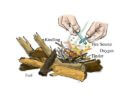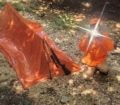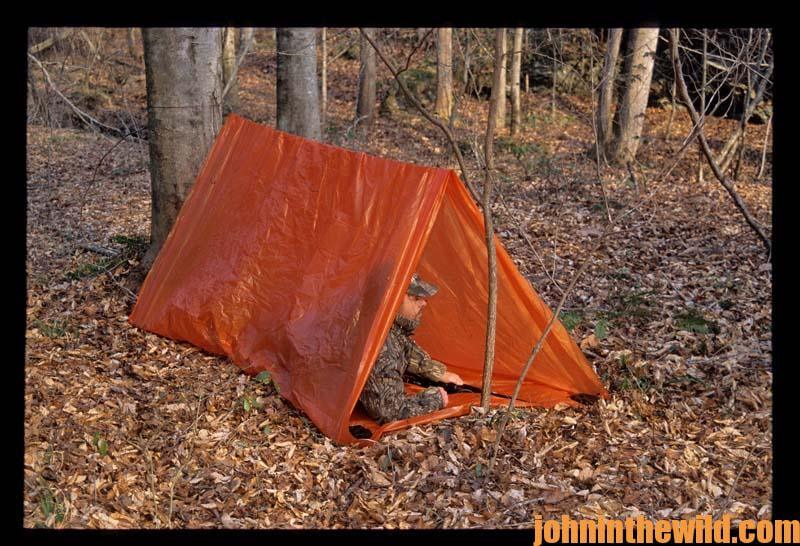Editor’s Note: J. Wayne Fears first learned survival training from his father who was a trapper. He later received survival training from both the U.S. Army and the U.S. Air Force. He’s been responsible for running hunting operations in Alabama, Alaska, British Columbia, and Colorado. His new book “The Scouting Guide to Survival” is his 34th book on outdoor subjects and tells what Fears has learned from his decades of survival experiences.
 Every survivor, faced with the problem of protecting himself from the elements, must consider using every conceivable place already existing in his immediate area or using every available material at hand to improvise a place that will afford protection that is needed.
Every survivor, faced with the problem of protecting himself from the elements, must consider using every conceivable place already existing in his immediate area or using every available material at hand to improvise a place that will afford protection that is needed.
* A Tube Tent. One of the best survival shelters is the tube tent (https://www.coghlans.com/), which is easy and quick to set-up. You simply run a rope or cords through the plastic tube and tie it between two trees. Since these tents blow like a sail in high wind, it is a good idea to weigh down the front and rear openings with rocks or heavy logs. Tube tents do a good job of keeping you dry in wet weather, and they are excellent wind breaks and, due to their orange color, they make a good signal.
* Natural Shelters – The first rule in seeking natural shelter is to look around you to see if a natural shelter is near you that may save you time in setting-up your survival camp. A rock overhang or cave can make a good shelter. Many times freshly blown-down trees can be made into a survival shelter by cutting away the limbs near the ground. If large pieces of bark are around, use those to improve the roof. If the blown down tree has a huge root wad pulled up and leaning over, it can be made into a shelter with little effort. However, since this shelter blends in with the surroundings, be sure to put out plenty of signals, so that searchers will not overlook you. An evergreen tree with low growing limbs that come out from the trunk and slope down to near the ground can be made into a shelter with some trimming. This type shelter blends in with the forest and ground, so, a fire is required for searchers to see you from the air.
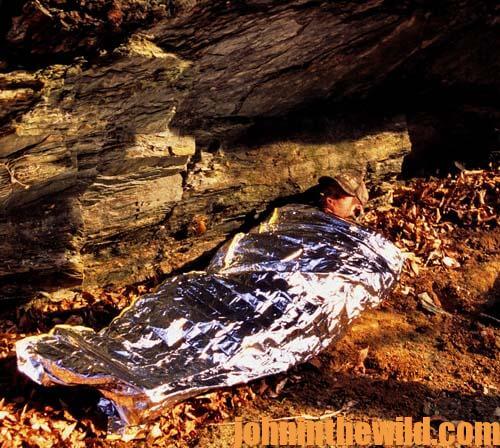
Emergency blanket
* Lean-Tos. A tarp or an emergency blanket, especially one in a metallic or bright orange color, is an extremely versatile shelter. It can be stretched alongside an overturned canoe to form a lean-to. It makes a good lean-to, especially when trying to escape desert heat. A rain-proof lean-to is good in cold weather because when used with a reflector fire, the shelter can be comfortable in the worst of weather.
 * Hole-in-the-Snow Shelter. Find an evergreen tree having limbs extending down to snow level, and then dig out all the snow around its trunk right down to the ground. Next, trim all the inside branches, and use them to line the bottom and finish the top. Since this shelter is hidden, be sure to keep your ground-to-air signals out and clean of snow, as well as laying out brightly colored items in an opening.
* Hole-in-the-Snow Shelter. Find an evergreen tree having limbs extending down to snow level, and then dig out all the snow around its trunk right down to the ground. Next, trim all the inside branches, and use them to line the bottom and finish the top. Since this shelter is hidden, be sure to keep your ground-to-air signals out and clean of snow, as well as laying out brightly colored items in an opening.
 Many other crude shelters can be made. The secret to shelter construction is simple – use what is available to give yourself the protection necessary from the elements.
Many other crude shelters can be made. The secret to shelter construction is simple – use what is available to give yourself the protection necessary from the elements.
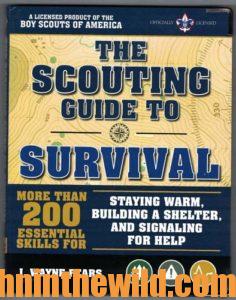 To learn more, you can buy a copy of the new book, “The Scouting Guide to Survival” by going to – www.amazon.com/J.-Wayne-Fears/e/B001HOIFOQ.
To learn more, you can buy a copy of the new book, “The Scouting Guide to Survival” by going to – www.amazon.com/J.-Wayne-Fears/e/B001HOIFOQ.

